Bohan Zhai
ExCoT: Optimizing Reasoning for Text-to-SQL with Execution Feedback
Mar 25, 2025Abstract:Text-to-SQL demands precise reasoning to convert natural language questions into structured queries. While large language models (LLMs) excel in many reasoning tasks, their ability to leverage Chain-of-Thought (CoT) reasoning for text-to-SQL remains underexplored. We identify critical limitations: zero-shot CoT offers minimal gains, and Direct Preference Optimization (DPO) applied without CoT yields marginal improvements. We propose ExCoT, a novel framework that iteratively optimizes open-source LLMs by combining CoT reasoning with off-policy and on-policy DPO, relying solely on execution accuracy as feedback. This approach eliminates the need for reward models or human-annotated preferences. Our experimental results demonstrate significant performance gains: ExCoT improves execution accuracy on BIRD dev set from 57.37% to 68.51% and on Spider test set from 78.81% to 86.59% for LLaMA-3 70B, with Qwen-2.5-Coder demonstrating similar improvements. Our best model achieves state-of-the-art performance in the single-model setting on both BIRD and Spider datasets, notably achieving 68.53% on the BIRD test set.
Law of Vision Representation in MLLMs
Aug 29, 2024



Abstract:We present the "Law of Vision Representation" in multimodal large language models (MLLMs). It reveals a strong correlation between the combination of cross-modal alignment, correspondence in vision representation, and MLLM performance. We quantify the two factors using the cross-modal Alignment and Correspondence score (AC score). Through extensive experiments involving thirteen different vision representation settings and evaluations across eight benchmarks, we find that the AC score is linearly correlated to model performance. By leveraging this relationship, we are able to identify and train the optimal vision representation only, which does not require finetuning the language model every time, resulting in a 99.7% reduction in computational cost.
InfiMM-HD: A Leap Forward in High-Resolution Multimodal Understanding
Mar 03, 2024Abstract:Multimodal Large Language Models (MLLMs) have experienced significant advancements recently. Nevertheless, challenges persist in the accurate recognition and comprehension of intricate details within high-resolution images. Despite being indispensable for the development of robust MLLMs, this area remains underinvestigated. To tackle this challenge, our work introduces InfiMM-HD, a novel architecture specifically designed for processing images of different resolutions with low computational overhead. This innovation facilitates the enlargement of MLLMs to higher-resolution capabilities. InfiMM-HD incorporates a cross-attention module and visual windows to reduce computation costs. By integrating this architectural design with a four-stage training pipeline, our model attains improved visual perception efficiently and cost-effectively. Empirical study underscores the robustness and effectiveness of InfiMM-HD, opening new avenues for exploration in related areas. Codes and models can be found at https://huggingface.co/Infi-MM/infimm-hd
Exploring the Reasoning Abilities of Multimodal Large Language Models (MLLMs): A Comprehensive Survey on Emerging Trends in Multimodal Reasoning
Jan 18, 2024



Abstract:Strong Artificial Intelligence (Strong AI) or Artificial General Intelligence (AGI) with abstract reasoning ability is the goal of next-generation AI. Recent advancements in Large Language Models (LLMs), along with the emerging field of Multimodal Large Language Models (MLLMs), have demonstrated impressive capabilities across a wide range of multimodal tasks and applications. Particularly, various MLLMs, each with distinct model architectures, training data, and training stages, have been evaluated across a broad range of MLLM benchmarks. These studies have, to varying degrees, revealed different aspects of the current capabilities of MLLMs. However, the reasoning abilities of MLLMs have not been systematically investigated. In this survey, we comprehensively review the existing evaluation protocols of multimodal reasoning, categorize and illustrate the frontiers of MLLMs, introduce recent trends in applications of MLLMs on reasoning-intensive tasks, and finally discuss current practices and future directions. We believe our survey establishes a solid base and sheds light on this important topic, multimodal reasoning.
COCO is "ALL'' You Need for Visual Instruction Fine-tuning
Jan 17, 2024Abstract:Multi-modal Large Language Models (MLLMs) are increasingly prominent in the field of artificial intelligence. Visual instruction fine-tuning (IFT) is a vital process for aligning MLLMs' output with user's intentions. High-quality and diversified instruction following data is the key to this fine-tuning process. Recent studies propose to construct visual IFT datasets through a multifaceted approach: transforming existing datasets with rule-based templates, employing GPT-4 for rewriting annotations, and utilizing GPT-4V for visual dataset pseudo-labeling. LLaVA-1.5 adopted similar approach and construct LLaVA-mix-665k, which is one of the simplest, most widely used, yet most effective IFT datasets today. Notably, when properly fine-tuned with this dataset, MLLMs can achieve state-of-the-art performance on several benchmarks. However, we noticed that models trained with this dataset often struggle to follow user instructions properly in multi-round dialog. In addition, tradition caption and VQA evaluation benchmarks, with their closed-form evaluation structure, are not fully equipped to assess the capabilities of modern open-ended generative MLLMs. This problem is not unique to the LLaVA-mix-665k dataset, but may be a potential issue in all IFT datasets constructed from image captioning or VQA sources, though the extent of this issue may vary. We argue that datasets with diverse and high-quality detailed instruction following annotations are essential and adequate for MLLMs IFT. In this work, we establish a new IFT dataset, with images sourced from the COCO dataset along with more diverse instructions. Our experiments show that when fine-tuned with out proposed dataset, MLLMs achieve better performance on open-ended evaluation benchmarks in both single-round and multi-round dialog setting.
InfiMM-Eval: Complex Open-Ended Reasoning Evaluation For Multi-Modal Large Language Models
Dec 04, 2023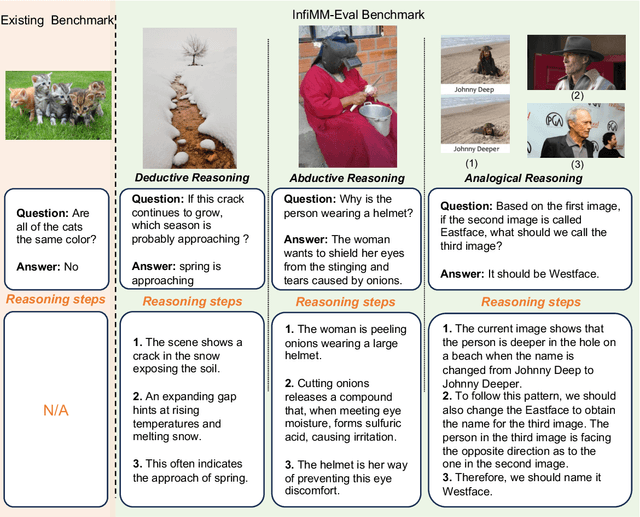
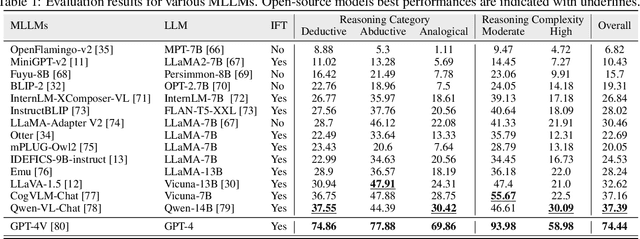
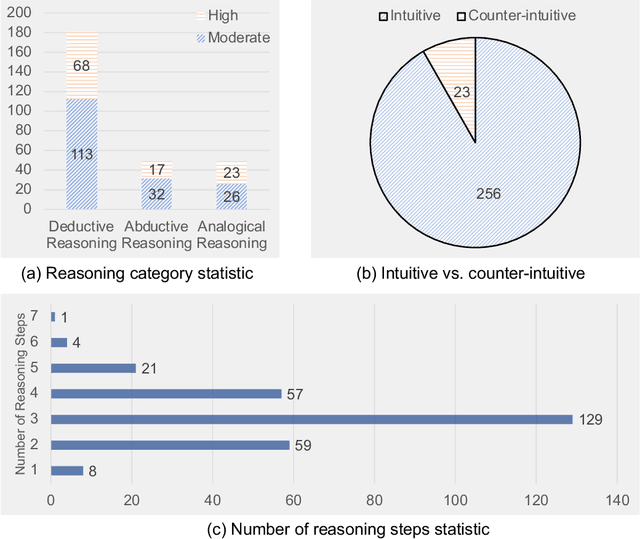
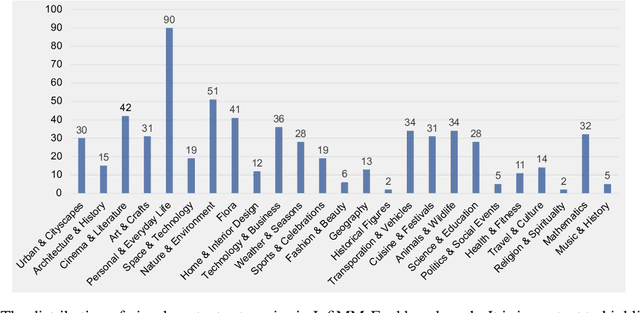
Abstract:Multi-modal Large Language Models (MLLMs) are increasingly prominent in the field of artificial intelligence. These models not only excel in traditional vision-language tasks but also demonstrate impressive performance in contemporary multi-modal benchmarks. Although many of these benchmarks attempt to holistically evaluate MLLMs, they typically concentrate on basic reasoning tasks, often yielding only simple yes/no or multi-choice responses. These methods naturally lead to confusion and difficulties in conclusively determining the reasoning capabilities of MLLMs. To mitigate this issue, we manually curate a benchmark dataset specifically designed for MLLMs, with a focus on complex reasoning tasks. Our benchmark comprises three key reasoning categories: deductive, abductive, and analogical reasoning. The queries in our dataset are intentionally constructed to engage the reasoning capabilities of MLLMs in the process of generating answers. For a fair comparison across various MLLMs, we incorporate intermediate reasoning steps into our evaluation criteria. In instances where an MLLM is unable to produce a definitive answer, its reasoning ability is evaluated by requesting intermediate reasoning steps. If these steps align with our manual annotations, appropriate scores are assigned. This evaluation scheme resembles methods commonly used in human assessments, such as exams or assignments, and represents what we consider a more effective assessment technique compared with existing benchmarks. We evaluate a selection of representative MLLMs using this rigorously developed open-ended multi-step elaborate reasoning benchmark, designed to challenge and accurately measure their reasoning capabilities. The code and data will be released at https://infimm.github.io/InfiMM-Eval/
HallE-Switch: Rethinking and Controlling Object Existence Hallucinations in Large Vision Language Models for Detailed Caption
Oct 03, 2023
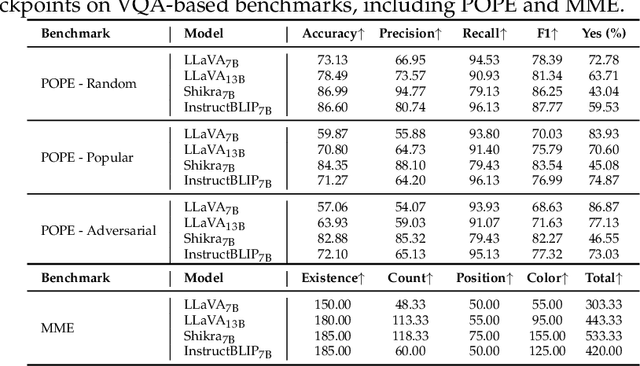

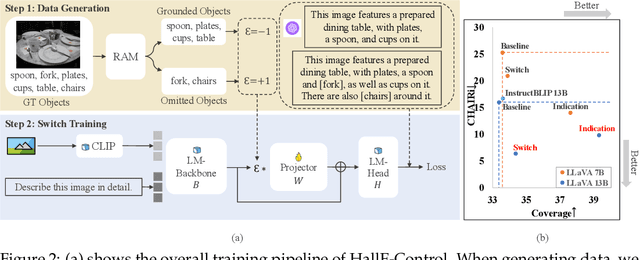
Abstract:Current large vision-language models (LVLMs) achieve remarkable progress, yet there remains significant uncertainty regarding their ability to accurately apprehend visual details, that is, in performing detailed captioning. To address this, we introduce \textit{CCEval}, a GPT-4 assisted evaluation method tailored for detailed captioning. Interestingly, while LVLMs demonstrate minimal object existence hallucination in existing VQA benchmarks, our proposed evaluation reveals continued susceptibility to such hallucinations. In this paper, we make the first attempt to investigate and attribute such hallucinations, including image resolution, the language decoder size, and instruction data amount, quality, granularity. Our findings underscore the unwarranted inference when the language description includes details at a finer object granularity than what the vision module can ground or verify, thus inducing hallucination. To control such hallucinations, we further attribute the reliability of captioning to contextual knowledge (involving only contextually grounded objects) and parametric knowledge (containing inferred objects by the model). Thus, we introduce $\textit{HallE-Switch}$, a controllable LVLM in terms of $\textbf{Hall}$ucination in object $\textbf{E}$xistence. HallE-Switch can condition the captioning to shift between (i) exclusively depicting contextual knowledge for grounded objects and (ii) blending it with parametric knowledge to imagine inferred objects. Our method reduces hallucination by 44% compared to LLaVA$_{7B}$ and maintains the same object coverage.
Multitask Vision-Language Prompt Tuning
Dec 05, 2022Abstract:Prompt Tuning, conditioning on task-specific learned prompt vectors, has emerged as a data-efficient and parameter-efficient method for adapting large pretrained vision-language models to multiple downstream tasks. However, existing approaches usually consider learning prompt vectors for each task independently from scratch, thereby failing to exploit the rich shareable knowledge across different vision-language tasks. In this paper, we propose multitask vision-language prompt tuning (MVLPT), which incorporates cross-task knowledge into prompt tuning for vision-language models. Specifically, (i) we demonstrate the effectiveness of learning a single transferable prompt from multiple source tasks to initialize the prompt for each target task; (ii) we show many target tasks can benefit each other from sharing prompt vectors and thus can be jointly learned via multitask prompt tuning. We benchmark the proposed MVLPT using three representative prompt tuning methods, namely text prompt tuning, visual prompt tuning, and the unified vision-language prompt tuning. Results in 20 vision tasks demonstrate that the proposed approach outperforms all single-task baseline prompt tuning methods, setting the new state-of-the-art on the few-shot ELEVATER benchmarks and cross-task generalization benchmarks. To understand where the cross-task knowledge is most effective, we also conduct a large-scale study on task transferability with 20 vision tasks in 400 combinations for each prompt tuning method. It shows that the most performant MVLPT for each prompt tuning method prefers different task combinations and many tasks can benefit each other, depending on their visual similarity and label similarity. Code is available at https://github.com/sIncerass/MVLPT.
Image2Point: 3D Point-Cloud Understanding with Pretrained 2D ConvNets
Jun 08, 2021



Abstract:3D point-clouds and 2D images are different visual representations of the physical world. While human vision can understand both representations, computer vision models designed for 2D image and 3D point-cloud understanding are quite different. Our paper investigates the potential for transferability between these two representations by empirically investigating whether this approach works, what factors affect the transfer performance, and how to make it work even better. We discovered that we can indeed use the same neural net model architectures to understand both images and point-clouds. Moreover, we can transfer pretrained weights from image models to point-cloud models with minimal effort. Specifically, based on a 2D ConvNet pretrained on an image dataset, we can transfer the image model to a point-cloud model by \textit{inflating} 2D convolutional filters to 3D then finetuning its input, output, and optionally normalization layers. The transferred model can achieve competitive performance on 3D point-cloud classification, indoor and driving scene segmentation, even beating a wide range of point-cloud models that adopt task-specific architectures and use a variety of tricks.
Q-ASR: Integer-only Zero-shot Quantization for Efficient Speech Recognition
Mar 31, 2021



Abstract:End-to-end neural network models achieve improved performance on various automatic speech recognition (ASR) tasks. However, these models perform poorly on edge hardware due to large memory and computation requirements. While quantizing model weights and/or activations to low-precision can be a promising solution, previous research on quantizing ASR models is limited. Most quantization approaches use floating-point arithmetic during inference; and thus they cannot fully exploit integer processing units, which use less power than their floating-point counterparts. Moreover, they require training/validation data during quantization for finetuning or calibration; however, this data may not be available due to security/privacy concerns. To address these limitations, we propose Q-ASR, an integer-only, zero-shot quantization scheme for ASR models. In particular, we generate synthetic data whose runtime statistics resemble the real data, and we use it to calibrate models during quantization. We then apply Q-ASR to quantize QuartzNet-15x5 and JasperDR-10x5 without any training data, and we show negligible WER change as compared to the full-precision baseline models. For INT8-only quantization, we observe a very modest WER degradation of up to 0.29%, while we achieve up to 2.44x speedup on a T4 GPU. Furthermore, Q-ASR exhibits a large compression rate of more than 4x with small WER degradation.
 Add to Chrome
Add to Chrome Add to Firefox
Add to Firefox Add to Edge
Add to Edge